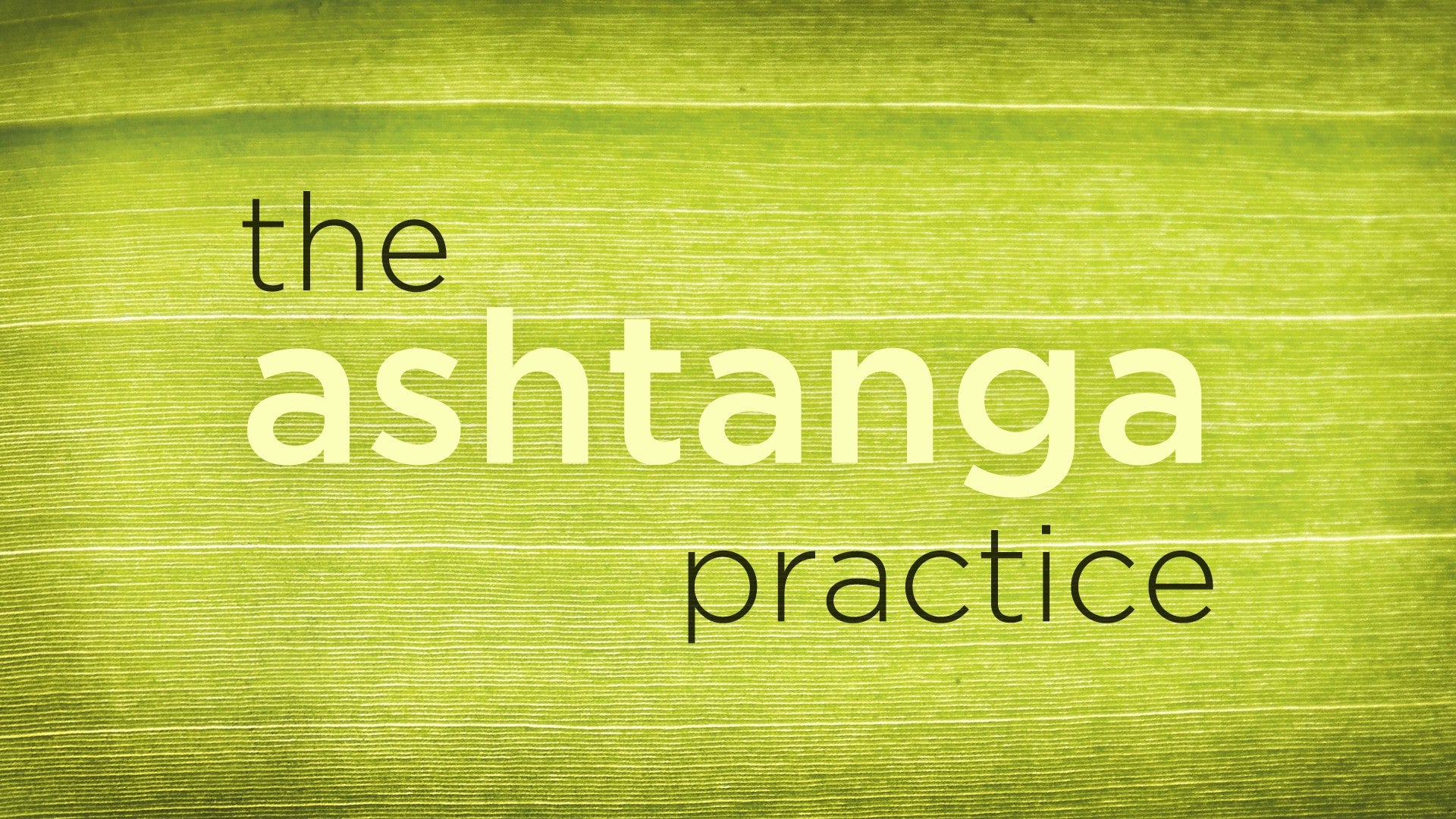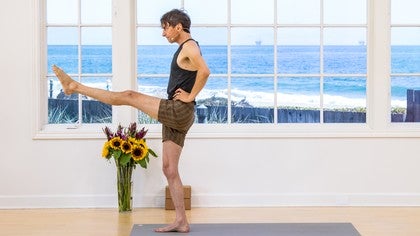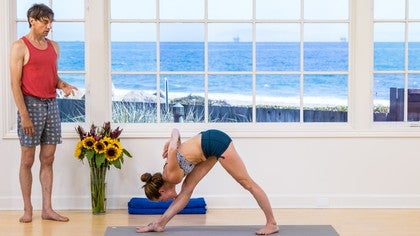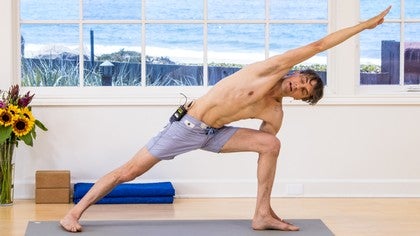Description
About This Video
Transcript
Read Full Transcript
(waves gently crashing) Greetings. Welcome to this seventh session. So today we're gonna do a little old school Ashtanga work in the beginning. So my teacher, when he taught the led class, he would only give very small amount of cuing, and he would tell you the posture name, and you counted the Vinyasa position in Sanskrit, and he would count the breathing. And so we're gonna play with that today.
Such an amazing thing that all of a sudden, space opens up, so you're not getting instruction about putting this foot here or twisting or Asana action, and something else comes through, then. The rhythm and the breathing, and a kind of intuition that is the subject of today's theme, the limb of Dhyana, the seventh limb, which I'm calling intuition creativity. And so in limb six, in concentration, there's a mechanical aspect to kind of concentrating your mind, like, logistical. Like you can do the Asana actions because you can concentrate your mind, but then there's a further step to go further in which is like an ability to synthesize the information, to take the information that comes in and work with it spontaneously in the moment and come up with something, an expression of some sort or a problem solving or enter into a new consciousness. So it's a very amazing thing, and notice that it's intuition so there's this inner trust aspect that you're coming to.
And so this old school way of going through that we're gonna work with in the beginning is very nice with that because you get that space to think for yourself and make things happen, and it can bubble up from inside of you and be expressed. Okay, so we're gonna bring Shelly back for this little round and we'll get started. Welcome back, Shelly. Here we go, Samastitihi. Ekam, inhale, arm up.
Dve, exhale. Treeni, inhale, head up. Chatvaari, jump back. Pancha, inhale. Shat, exhale.
So now Ujjayi breathing, five counts. One. Two. Three. Four.
Five. Sapta, jump. Inhale. Ashta, exhale. Nava, inhale, arms up.
Samastitihi. Ekam, inhale. Dve, exhale. Treeni, inhale, head up. Chatvaari, jump back.
Pancha, inhale. Shat, exhale. One. Two. Three.
Four. Five. Sapta, jump. Inhale. Ashta, exhale.
Nava, inhale, arms up. Samastitihi. Last one, ekam, inhale. Dve, exhale. Treeni, inhale, head up.
Chatvaari, jump back. Pancha, inhale. Shat, exhale. One. Two.
Three. Four. Five. Sapta, jump. Inhale.
Ashta, exhale. Nava, inhale, arms up. Samastitihi. Surya Namaskar B. Ekam, inhale.
Dve, exhale. Treeni, inhale, head up. Chatvaari, jump back. Pancha, inhale. Shat, exhale.
Sapta, step right leg. Inhale, arms up. Ashta, exhale. Nava, inhale. Dasha, exhale.
Ekaadasha, step left leg. Inhale, arms up. Dvaadasha, exhale. Trayodasha, inhale. Chaturdasha, exhale.
Five breathing. One. Two. Three. Four.
Five, panchadasha, jump, inhale. Shodasha, exhale. Saptadasha, inhale, arms up. Samastitihi. Ekam, inhale.
Dve, exhale. Treeni, inhale, head up. Chatvaari, jump back. Pancha, inhale. Shat, exhale.
Sapta, step right leg, inhale. Ashta, exhale. Nava, inhale. Dasha, exhale. Ekaadasha, step left leg.
Inhale. Dvaadasha, exhale. Trayodasha, inhale. Chaturdasha, exhale. One.
Two. Three. Four. Five. Panchadasha, jump, inhale.
Shodasha, exhale. Saptadasha, inhale, arms up. Samastitihi. Last one. Ekam, inhale.
Dve, exhale. Treeni, inhale, head up. Chatvaari, jump back. Pancha, inhale. Shat, exhale.
Sapta, step right leg. Inhale. Ashta, exhale. Nava, inhale. Dasha, exhale.
Ekaadasha, step left leg. Inhale. Dvaadasha, exhale. Trayodasha, inhale. Chaturdasha, exhale.
One. Two. Three. Four. Five.
Panchadasha, jump, inhale. Shodasha, exhale. Saptadasha, inhale, arms up. Samastitihi. Padangusthasana.
Ekam. Inhale, lift the chest, come halfway forward, catch your big toes. Again inhale. Dve, exhale, fold forward. One.
Two. Three. Four. Five, treeni, inhale. Padangusthasana.
Ekam, take the hands under the feet. Again, breathe in. Dve, exhale. One. Two.
Three. Four. Five. Treeni, inhale. Exhale.
Samastitihi. Utthita Trikonasana. Ekam, inhale. Dve, exhale. One.
Two. Three. Four. Five, treeni, inhale. Chatvaari, exhale.
One. Two. Three. Four. Five, pancha, inhale.
Parivrtta Trikonasana. Dve, exhale. One. Two. Three.
Four. Five, treeni, inhale. Chatvaari, exhale. One. Two.
Three. Four. Five, pancha, inhale. Samastitihi. Utthita Parsvakonasana.
Ekam, inhale. Dve, exhale. One. Two. Three.
Four. Five. Treeni, inhale. Chatvaari, exhale. One.
Two. Three. Four. Five. Pancha, inhale.
Come up. Parivrtta Parsvakonasana. Dve, exhale. One. Two.
Three. Four. Five. Treeni, inhale. Chatvaari, exhale.
One. Two. Three. Four. Five.
Pancha, inhale. Samastitihi, jump. Prasarita Parsvakonasana. Ekam. Inhale.
Dve, exhale. Come halfway down. Stop there, inhale again. Treeni, exhale, fold. One.
Two. Three. Four. Five. Chatvaari, inhale.
Exhale. Pancha, come up. Samastitihi. Parsvotanasana. Ekam.
Inhale. Dve, exhale. One. Two. Three.
Four. Five. Treeni, inhale. Chatvaari, exhale. One.
Two. Three. Four. Five. Pancha, inhale.
Samastitihi. Utthita Hasta Padangusthasana. Ekam, inhale. Dve, exhale. One.
Two. Three. Four. Five. Treeni, inhale.
Chatvaari, exhale, swing it to the side. One. Two. So you're looking to the opposite side. Three.
Four. Five, pancha, inhale. Shat, exhale. Sapta, take back the arm, keep the leg up. One.
Two. Three. Four. Five. Ashta, second side.
Nava, exhale. One. Two. Three. Four.
Five, dasha, inhale. Ekaadasha, exhale. One. Two. Three.
Four. Five. Dvaadasha, inhale. Trayodasha, exhale. Chaturdasha, take back the arm.
One. Two. Three. Four. Five.
Samastitihi. (foreign) Tadasana. Ekam. Inhale. Just remember your options, you can be in tree or stay upright here.
Dve, exhale. You don't need to bind the lotus necessarily. One. Two. Three.
Four. Five. Treeni, inhale. Exhale. Chatvaari, come up.
Pancha, release. Shat, second side. Sapta, exhale. One. Two.
Three. Four. Five, ashta, inhale. Pause there, exhale. Nava, inhale, come up.
Establish control and Samastitihi. Okay so, this is where we've gone up to, now we're gonna take you through with Shelly the last part of the standing poses, and you've done all of the positions in different ways but this is a little different twist, okay? So here we go. We flow through Surya Namaskar to get to Utkatasana, fierce posture. Here we go.
Ekam, inhale. Dve, exhale. Treeni, inhale, head up. Chatvaari, jump back. Pancha, inhale.
Shat, exhale. So here we go. Utkatasana, sapta, jump. Come up into the posture and one. Two.
Three. Four. Five. Ashta, up. Nava, chatvaari, jump back.
Dasha, inhale. Ekaadasha, exhale. Okay so from downward dog then you step into warrior one, right side. Ashta. One.
Two. Three. Four. Five. Then keep the arms up, straighten the right leg and turn for the second side.
Ashta, exhale. Come down in warrior one on the second side. One. Two. Three.
Four. Five. Nava, now Virabhadrasana B. On that same side. So you're lunging with the left leg.
One. Two. Three. Four. Five.
Dasha, come up, exhale, second side. One. Two. Three. Four.
Five. Ekaadasha, up. Dvaadasha, chatvaari, jump back. Trayodasha, inhale. Chaturdasha, exhale.
So now Paschimottanasana. Crouch, sapta, jump through, straight leg, sit down. Dandasana. Five breaths. One.
Two. Three. Four. Five. Paschimottanasana.
Catch the big toes, inhale, head up. Ashta, exhale, fold. One. Two. Three.
Four. Five. Nava, inhale. Halfway up and then again, reach. See if you can get a little further forward.
Again, breathe in. Nava, exhale. One. Two. Three.
Four. Five. Dasha, head up. Exhale. So now set yourself up for the Vinyasa.
Bend the knees, cross the ankles, get ready and ekaadasha, (foreign) jump back. Trayodasha, inhale. Chaturdasha, exhale. Purvottanasana, sapta, jump through, sit down. So the eastern stretching pose.
Take back the arms 12 inches, fingers facing forward. Astha, inhale, come up. One. Two. Three.
Four. Five. Nava, come down. Set up for your jump back. Dasha, up.
Ekaadasha (foreign), jump back. Dvaadasha, inhale. Trayodasha, exhale. Sapta, jump through, sit down. All right, there we have it.
Some of you will, no problem. That was no problem. Some, maybe you were challenged. Some maybe left (chuckles). But if it was a challenge to you, you can go back to other episodes and repeat, and eventually you'll be able to do this, so keep revisiting it.
And you could start with a Surya Namaskar and kind of add into it. You don't necessarily need to do this all in one shot. Okay, so thank you, Shelly. And we'll move on to some other things now. Okay, so now we're going to skip a little bit, and just do a sampling so that by the time, at the end, you're gonna have a kind of well-balanced routine to work with, okay?
And so the next posture we're gonna do is Janu Sirsasana A. We'll take the right leg back, and so you're working that foot, the right foot. It doesn't come up against the left leg, and it goes a little bit away from it. And it's kind of easier if you position the knee forward. So the further you take the thigh back, the more challenging it gets.
So you can choose according to your taste and circumstances. And then there's a twist. It's an amazing position. This is a classic posture. Reach the arms up.
And feel like you're working with Dandasana principles. But you have a Janu Sirsasana set up. So lift up the navel, lift the chest. Reach up through the arms and then get heavy thighs. So the thighs ground and you project out through the left leg, and you even project it out through the right thigh.
Okay so from there (exhales sharply), come halfway forward. Keep reaching through the arms, and extending out on the diagonal, grounding the thigh bones, reaching through the left leg. So you can see, the body starts to get tired, you wanna take your arms down (chuckles), but you keep working. And then finally do bring the arms down. You can take them on your shin, onto your foot, or attach the right wrist around, according to how you want to work on a given day and what your limits are.
Okay so we're in the setup position still, we haven't actually folded forward yet. So you want to really enjoy and investigate that setup position, and then with a move, you come forward. The thighs stay active, rooting into the earth, so you elongate and there's a turn, a kind of twist, as you revolve the spine and center yourself over that left leg. Okay so suppose, come back up. Now you can bend the knee, of course.
You can sit on a blanket, and you can also, if your head doesn't come all the way to your leg with ease, you can take some kind of, like your carpet or a blanket and it's a very nice feeling to (exhalation). Drop your body down onto something. So try it out, you can do it with a block, with a blanket. And even if you can do a deeper fold, a very nice exploration. So take your position.
And you can feel, you can relax the brain and kind of let the non-action, non-effort element enter into your contemplation, your expression of the shape. Then inhale, lift the head and chest and release, and we'll try the second side. Okay so bring the left leg back. Remember that you're kind of deciding partly the challenge level that you wanna work. You could take the leg way back and create more of a twist if you like or keep it more forward, and then plant the femurs so they ground and you reach up through the arms and twist.
So revolve the navel to the right. Reach out through the right leg. Enjoy the vertical axis from pelvic floor to fingertips. And then halfway forward, so you're reaching up and away on the diagonal. A very active move.
All right then, choose your hand position. Get your head support if you want to use it. And come down. So part of forward bending is engaging your foundation. Be very active through the limbs, and then there's another aspect that's spinal release, dropping.
You really have to have that active feeling through the limbs to get the benefits of that spinal release. And halfway up. Lift the chest, and release. Return to Dansasana. Okay then, we're gonna explore one more classic Asana, a twist, Marichyasana C.
So if you want to make it easier for yourself to get the feeling of the spinal rotation and work with the posture, you'll sit on a blanket. So, you can make your choice. So from Dandasana with a move, so you always wanna be active with your limbs. You, whoom, bring that right leg back and stamp it down, so it comes all the way back to the outer sitting bone. Notice that it's not in here, my left thigh.
The right foot is out to the side a bit, okay, and it's funny. I always remind people, this is easy to forget that the most important thing about a twist posture. It's a trick question. It's the twist. So we get all lost in binding.
I gotta bind and forget all about the twist. Okay, so first, wow, lift up the spine and turn to the right and just enjoy. Stamp the right foot down, ground the left thigh and turn. And then every move you make to go deeper into the posture keeps working with that rotation. So make a right angle between your left upper arm bone and forearm and make a fist.
So it's like this, and then put your right hand on your right thigh and push across, so you push that leg across the middle and get the upper arm bone at the left arm against the right outer leg, and keep that right angle, and push. So push your left arm against your right foot and resist. And then notice, you can use that leverage to enhance your twist. So I've got my right hand back, but I'm not leaning way back. Staying centered in my, over my hip foundation.
Okay and then release. Return to Dandasana and left. Stamp the left foot down the outer, towards the outer left sitting bone. Lift up and turn to the left. Okay no hands at first.
If you don't involve your limbs, simply work it, and then you'll strengthen your core and keep your spine healthy. Then when you wanna add the limbs, make a right angle between your right upper arm bone and forearm, make a fist, and that fist is coming kind of over the top this way, and then take your left hand, push your left leg across the middle, twist, and take the upper arm bone of the right arm to the outer left leg, and continue to work, stamping the left foot down, grounding the right thigh. If you put the left arm behind you, cup your fingers, go onto the fingertips and stay centered over the foundation. So that's an amazing twist. If you did wanna go further, you could internally rotate that left arm and sneak that around.
So the palm faces out behind you and then reach and catch and continue to plant the left foot, right thigh, lift up the navel, lift up the chest and turn. And release. Return to Dandasana. Okay and then we'll transition into our inversion portion of the session. So we're gonna do shoulder stand first with the support today.
You can always consult my tutorial on the inversions to figure out the good option for you and then use that option during these sessions. You don't necessarily have to do it like I'm gonna do it. You could be at the wall. Be using that where you put your hands on your pelvis more. So remember, you have options, and that's part of our theme with the seventh limb, Dhyana, there's a synthesis.
So you're able to, limb number six is like, you're able to follow rules to the tee, accurately, but limb number seven, you're able to interpret the rules and individualize and synthesize and come up with ideas and solutions of your own. So it's a very important aspect to develop into as you mature in your practice. Here I come, up into my shoulder stand. So I'm clarifying that foundation. So remember that's your protection.
The hands, the forearms, the upper arms, across the upper back, that's what's taking the weight of the body. So if somebody came and tried to move my hand off my back, it wouldn't be easy, they would have to pull. So if there's no weight in your hand, it could just come right off your back, and then that's a sign to you that something's not right, and you may need to go to an earlier stage like work at the wall to kind of get some skill. Okay and one of the things about inversions is, it's challenging. It's challenging physically, but it's also challenging mentally.
The mind starts getting bored, starts going, "Let's get out of here. "This is no good. "This is too hard. "My neck is getting uncomfortable." And so, you introduce variety to kind of distract the mind from wanting to exit. So here we go.
You can take the tree position, right, so take your right leg out on the diagonal and with a flip, flip the right foot to the inner left thigh, and you're getting as close to the pelvis as you can with that right foot. And then reach up through the left leg. So immediately when the mind gets a different project, oh no, I'm focusing on the foot. Suddenly the posture becomes a little lighter. And flip the right leg out, return to Sarvangasana, retake your hand foundation and left.
So swing it out on the diagonal and flip the left leg to the left foot to the inner right thigh. Reach up through the right leg, and enjoy. So the chest is open, the weight of the body is being born on the arm foundation. And flip the leg out. Come back to a vertical position, and we'll try half plow, so swing the right leg down.
It may not go all the way to the ground, and to keep the legs straight. And keep your left leg vertical so the ankle, knee, hip, shoulder all in one line. And work your left leg. Excuse me, work your right leg down with extension, and then swing that leg back up the right leg to Sarvangasana, we'll try the left. Hinge at the hip and swing the left leg down, wherever it comes to is just fine.
So you've got the vertical right leg, ankle, knee, hip, shoulder. You're extending the left leg. Enjoying the position. The weight of your body in your arm foundation. Relaxed throat.
And swing the left leg up to Sarvangasana. And then release your arms and come down, back up, so that you get your shoulder blades on the mat off of your support, and rest your neck for a few moments. Keep those senses tracking inside the body, internal gaze, internal listening, internal feeling. So that's part of how you awaken intuition. Tracking the senses inside the body and then vision comes, or a song, melody.
Some expression of feeling. All right, so here we go, come up. And we'll work with our headstand. Okay and again, remember to consult the video tutorial on inversions to figure out the best option for you to work, and then you can do that option right now even if I'm not doing it. So you might be at the wall right now, working with the foundation or taking one leg up at a time, but today I'm coming up.
So here we go, I take my foundation, walk the feet in, and then I've been teaching you the crouch and spring to come up, but I'm coming up with straight legs today, so wow, right up to a vertical position. You can try that out or not as you like. So once you're up, stamp the forearms down. Contemplate Samastitihi. So the legs are grounded, the coccyx is curled slightly.
Your vestige of a tail is going across the pelvic floor to meet the pubic bone, and the pubic bone does not really like that idea, so you lift the navel and the pubic bone Follows the navel. Suck the ribs in any bit. You're trying to find a very fine balance point on your head, and so you're grounding your arms and establishing the foundation that way, but you're also getting precision with the vertical line, and you come to such a fine tune of balance that it doesn't take very much energy or strength to hold up the position. Okay I'm gonna come down the same way with a move, with swinging the legs down with control, and then keep your head on the ground and go onto the forehead into child's pose. And push yourself up.
You will go through a Vinyasa, so step back to plank and lower, then inhale to upward facing dog. Pull the hips back to downward dog, crouch, and come through to sit down. And we're gonna work with a little bit of Prana Yama before we do Shavasana, a little breathing. So you can take Padmasana. So if you're gonna take Padmasana, remember the move.
So you lift your right leg and like a frog, kick away through the heel and then dexterously, whoom, try to swing that leg across the thigh. Okay? So it's very active hip. That's what you want. See look at this.
You want that femur to go that way as you flip the leg into lotus, and then the second one. Flip (chuckles). It's actually quite hard to do. But look, no hands. Okay so you practice it.
And no forcing. So suppose you're like this, flip. No problem, you work at it, so you're trying to make that right leg go down and the left over, but if it doesn't quite make it, practice. It'll come eventually. Okay so you wanna avoid over using your arms and forcing yourself into a position.
So if you can't do lotus, half lotus will do. If you can't do half lotus, then this kind of Sukhasana will do, which is kind of like cross legged position but you lock that right foot in and come to a position like this. This is one of my favorite positions actually, and I like to do it with a blanket. I sit on just a little bit of height so I can get that very nice vertical arrangement. The head, torso, pelvis.
Okay so sit tall, enjoy your foundation. And remember we're Ujjayi. So you're creating resistance in the throat by partially closing the glottis, that's your swallowing muscle. So you wanna get control of that. So that when you breathe in, it's a pull.
You're actually pulling to get the breath to come in against resistance in the throat. And when you breathe out, you're pushing against that resistance. So stamp your hands onto your legs. And breathe along the axis, so the contractile force of the exhalation descends to the pelvic area and the expansion force of the inhalation ascends the very top of the chest. And calmly.
Attentively. Extending the cycle of the breath and enjoying the gaps at the end. So when your lungs are full before breathing out, just note that gap. And then when you empty, note that gap. And then fill up.
So simply playing with several cycles of breath. With a lowered gaze. Okay and we'll lay back for Shavasana. So come into your Samastitihi, your horizontal Samastitihi. Make the body like a dunda, like a staff, so charged with energy, full of vitality, the opposite of a corpse.
Shot through with pranic force. Enjoy that. But then enjoy the release of that. Separate the arms and legs. Shut the eyes.
Let the body settle and be caught by the earth. In the Hindu stories, the earth is a goddess named Prithvi. She's the inexhaustible source of abundance. So when you drop your weight and let her catch it, you are nourished by that abundance. Healed.
And use that earth to create Dhyana. Inward absorption along the central line. All right, you can stay as long as you like, or come up and out. In closing our themes, such a good one, that intuition and trust and creativity. And so if you only stay in that lower mind, in the kind of rural following bureaucrat, then eventually your mind will become a torturer, okay.
The mind gets stuck on concepts and ideas and perfection and becomes a serious critic. And so part of the, you have to kind of flip the mind to get to a creative place, and withstand doubt and fear and these things and so, partly, there's a little bit of a radical aspect to it. You have to get tough and strong and work. So it's kinda like this sound. It's like a calling out to saying, "I'm here! "And I belong here!" Okay, so listen to this sound.
(blows horn) All right. Such power, that intuition, Dhyana. Inward absorption. Listen again. (blows horn) All right look forward to tomorrow's session.
Namaste.
The Ashtanga Practice: David Garrigues
Comments
loveandpeacexxx
You need to be a subscriber to post a comment.
Please Log In or Create an Account to start your free trial.










